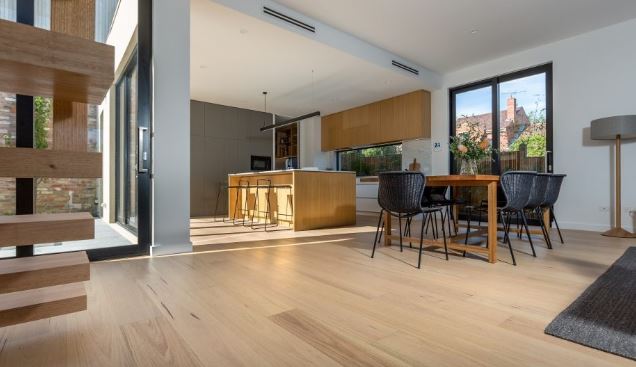Fashion and style seems to follow a strange cyclic pattern. Every few decades we glance into the past for inspiration. It might be that we’ve run out of ideas, or it may be a wave of nostalgia. Whatever the trigger, we periodically tap previous trends, giving them a modern touch and refreshing them with advanced technology. In the media world, this comes in the form of remakes. Hundreds of classics have been re-filmed ‘with a twist’.
Actors of colour instead of Caucasians, female leads instead of male, younger starring roles, updated settings, tweaked backstories, diverse cultural backgrounds. It’s how we’ve ended up with a female Dr. Who, and black Spiderman, and a lesbian charmed witch. In the fashion world, it expresses itself through retro catwalk looks and vintage clothes. In the construction industry, it’s more about ancient architecture and old-world décor.
How does this tie to engineered flooring? Well, wood was probably one of the earliest construction materials. When our ancestors came out of caves and started to build for themselves, the most accessible materials were wood, stone, and mud. They also used animal parts, like bones and dried out skins. Now in the 21st Century, we’re looking back at timber, though our approach is different, because we’ve wiped out a lot of our forestry and want to protect what’s left. That’s the main appeal of engineered floors – conservation … and cost.
Wooden rugs
Many sources suggest floorboards appeared in the 1960s, but there are traces of its predecessors as early as the 1900s. This evidence is found – of all places – in a mail order catalogue. Someone named E.L.Roberts came up with the brilliant idea to sell ‘wooden carpets’. They didn’t need cleaning like conventional carpets, and looked rather stylish. Remember, building a log house may once have been seen as a sign of low means, but now, people with fancy homes who could afford wooden floors were seen as elite.
This perception continues to date, where wood flooring is considered more elegant and refined that plain old tile. But solid wood – then and now – was ironically expensive. It went from being a sign of low-tech construction (after all, it’s basically made with logs and driftwood gathered from the … woods … rather than quarried stone or designer tile) to being an elegant construction material exported from exotic woodland sites. Anyway, back to Roberts. His/her wood carpet was more decorative than functional.
Basically, a canvas sheet was overlaid with 8mm by 8cm wooden planks. The planks were glued in place then coated with Chinese tung oil. To extend the lifespan of the oil (which made the wood shine for a limited time), a layer of hot wax was poured over the oil, then brushed by hand until it had a gorgeous glow. This carpet was attached to your floor using brads (brass paper fastenings). Naturally, your carpet needed regular replacement.
Swinging sixties
Construction had shifted slightly, and modern multi-storey houses were becoming more common. These commercial cookie-cutter houses didn’t have the stately elegance of ancient castles and towers (those had multiple floors as well). The idea was to use quick, convenient construction materials and replicable house designs. Usually, the basement and ground floor were made of concrete. To improve aesthetics, the concrete was topped with wood. But because solid wood was expensive and complex, they used planks.
These planks – or engineered floors – were lighter and cheaper than solid wood. They were formed by creating layers of cheap timber sandwiched between more pricy solid surfaces. Often, the top and boom layers were veneer or laminate. The latter being a printed paper surface designed to look like real wood, and sometimes embellished with embossing to mimic wooden texture. The middle layers were plywood, composite, scrap wood, block-wood, recycled lumber, MDC, and sometimes even compressed paper.
Easy flooring
To make the ‘sandwich-filling’ stronger, the layers are arranged in different directions, sometimes at right angles. Each layer has a set thickness, depending on the specs of its manufacturers. Some brands only use three layers, others use a dozen or more. Some layers are 6mm thick, others go up to 2cm. Some engineered boards have ‘waste-wood’ in the centre layers, others use multiple layers of solid wood. The thicker the top layer, the longer your engineered floor lasts, because you sand it down and refinish as it ages.
Maintaining engineered flooring is the same as taking care of solid wood floors, but because the middle layers are generally made of cheaper wood, the floors are lighter in weight, quicker to install, and cheaper to produce. Even the type of engineered floor that uses solid wood layers is more affordable, because three thinner 1-inch planks cost less than one solid 3-inch block. Modern engineered floors offer style and prestige at a fraction of the price.
Read Also:
